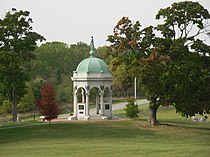Antietam National Battlefield
| Antietam National Battlefield | |
|---|---|
|
IUCN category V (protected landscape/seascape)
|
|

Bloody Lane at Antietam
|
|
| Location | Washington County, Maryland, U.S. |
| Nearest city | Sharpsburg, MD |
| Coordinates | 39°28′N 77°44′W / 39.47°N 77.74°WCoordinates: 39°28′N 77°44′W / 39.47°N 77.74°W |
| Area | 3,230 acres (13.1 km2) |
| Established | August 30, 1890 |
| Visitors | 384,987 (in 2011) |
| Governing body | National Park Service |
| Website | Antietam National Battlefield |
|
Antietam National Battlefield
|
|
| Location | N of Sharpsburg off MD 45, Sharpsburg, Maryland |
| Built | 1862 |
| NRHP Reference # | 66000038 |
| Added to NRHP | October 15, 1966 |
 |
|
|
|
Antietam National Battlefield is a National Park Service protected area along Antietam Creek in Sharpsburg, Washington County, northwestern Maryland. It commemorates the American Civil War Battle of Antietam that occurred on September 17, 1862.
The area, situated on fields among the Appalachian foothills near the Potomac River, features the battlefield site and visitor center, a national military cemetery, stone arch Burnside's Bridge, and a field hospital museum. Today, more than 330,000 people visit the park each year.
In the Battle of Antietam, General Robert E. Lee's first invasion of the North ended on this battlefield in 1862. Established as Antietam National Battlefield Site August 30, 1890, the park was transferred from the War Department August 10, 1933, and redesignated November 10, 1978. Along with all historic areas administered by the National Park Service, the battlefield was listed on the National Register of Historic Places on October 15, 1966. Additional documentation on the site was recorded by the National Park Service on February 27, 2009.
Antietam National Cemetery, which adjoins the park, covers 11.36 acres (4.60 ha) and contains more than 4,976 interments (1,836 unidentified). The cemetery was commissioned in 1865 and interments begun in 1867 after an arduous process of identifying the dead, which was only successful in about 40% of cases. Civil War era burials in this cemetery consist of only Union soldiers; Confederate dead were interred in the Washington Confederate Cemetery, Hagerstown, Maryland; Mt. Olivet Cemetery in Frederick, Maryland; and Elmwood Cemetery in Shepherdstown, West Virginia. The cemetery also contains the graves of veterans and their wives from the Spanish–American War, World War I and II, and the Korean War. The cemetery was closed to additional interments in 1953. Two exceptions have been made, the first in 1978 for Congressman Goodloe Byron and the second in 2000 for the remains of USN Fireman Patrick Howard Roy who was killed in the attack on the USS Cole. The cemetery was placed under the War Department on July 14, 1870; it was transferred to the National Park Service on August 10, 1933. The gatehouse at the cemetery's entrance was the first building designed by Paul J. Pelz, later architect of the Library of Congress
...
Wikipedia



